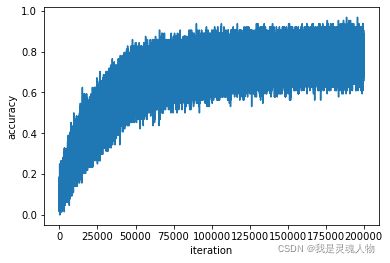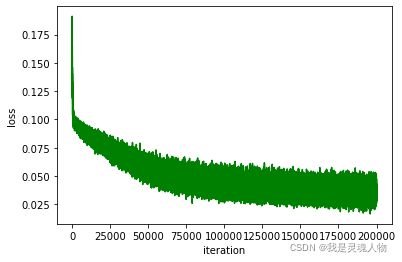Python——tensorflow2.8逻辑回归算法(mnist)
tensorflow在2.0以上去掉了mnist数据集的处理指令,如果要下载的话得转为keras来处理,但是下载的数据没办法减容next_batch()函数,所以我们可以使用另一种方法:把tensorflow.examples.tutorials.mnist import input_data这个程序里面所需要的库补齐。
首先查看你的site-packages里面的tensorflow有没有examples文件夹,如果没有的话就把附件里面整个example文件夹放进去,如果有但是程序提示没有tutorials那就把example里面的tutorials文件夹放进到你的路径中。
一、代码分析
这部分是用来设置计算采用CPU还是GPU的,把os.environ["CUDA_VISIBLE_DEVICES"]="-1"的“-1”改成0、1、2可以换成使用GPU来计算,但在这个例子中用不到。sess那句改成True可以看到你的GPU使用的情况。
这里我是用两层来计算,因为使用一层我发现准去率大概在95以下,两层可以提高到99;另外激活函数使用relu,在这个例子中使用softmax也一样的;优化器和loss值我试了两个,区别不大;最后保存一下准去率和loss,用来画图。
最终结果是这个样子的,其实没什么难度,但tensorflow2.0跟以前很多例子不一样,所以把一些资源放出来。
# -*- coding: utf-8 -*-
"""
Created on Mon Mar 28 22:18:35 2022
@author: peter
"""
import tensorflow as tf
import numpy as np
import matplotlib.pyplot as plt
import datetime
tf.compat.v1.disable_eager_execution()
import os
os.environ["CUDA_VISIBLE_DEVICES"]="0"
from tensorflow.examples.tutorials.mnist import input_data
sess = tf.compat.v1.Session(config=tf.compat.v1.ConfigProto(log_device_placement=True))
# =============================================================================
# import the dataset from keras.
# turn the labels into one-hot encoding
# =============================================================================
mnists = input_data.read_data_sets('data/', one_hot=True)
train_examples = mnists.train.images
train_labels = mnists.train.labels
test_examples = mnists.test.images
test_labels = mnists.test.labels
# =============================================================================
# show the data picture
# =============================================================================
nsample = 5
# =============================================================================
# # =============================================================================
# for i in range(nsample):
# cap_img = train_images[i,:]
# plt.matshow(cap_img,cmap=plt.get_cmap('gray'))
# plt.show()
#
# # =============================================================================
# =============================================================================
# =============================================================================
# build the model
# =============================================================================
batchSize = 64
numClass = 10
interaction = 200000
inputSize = 784
X = tf.compat.v1.placeholder(dtype = tf.float32,shape=[None,inputSize])
y = tf.compat.v1.placeholder(dtype = tf.float32,shape=[None,numClass])
W1 = tf.compat.v1.Variable(tf.compat.v1.random_normal([inputSize,numClass],stddev=0.1))
b1 = tf.compat.v1.Variable(tf.constant(0.1),[numClass])
h1 = tf.compat.v1.nn.relu(tf.matmul(X, W1)+b1)
W2 = tf.compat.v1.Variable(tf.compat.v1.random_normal([numClass,numClass],stddev=0.1))
b2 = tf.compat.v1.Variable(tf.constant(0.1),[numClass])
y_pred = tf.compat.v1.nn.relu(tf.matmul(h1, W2)+b2)
# y_pred = tf.matmul(h1,W2)+b2
# loss = tf.reduce_mean(tf.nn.softmax_cross_entropy_with_logits(logits=y_pred,labels=y))
loss = tf.reduce_mean(tf.square(y-y_pred))
# opt = tf.compat.v1.train.AdamOptimizer().minimize(loss)
opt = tf.compat.v1.train.GradientDescentOptimizer(learning_rate=0.001).minimize(loss)
correct_pre = tf.equal(tf.argmax(y_pred,1), tf.argmax(y,1))
accuracy = tf.reduce_mean(tf.cast(correct_pre, "float"))
sess = tf.compat.v1.Session()
init = tf.compat.v1.global_variables_initializer()
sess.run(init)
result_acc=[]
result_loss=[]
curr1 = datetime.datetime.now()
for i in range(interaction):
batchdata=mnists.train.next_batch(batchSize)
batchInput = batchdata[0]
batchLabels = batchdata[1]
# batchInput = get_nextBatch(start_batch, train_example)
# print("the shape of batchInput is {}".format(np.shape(batchInput)))
# batchLabels = get_nextBatch(start_batch, train_labels)
# print("the shape of batchInput is {} and batchLabels is {}".format(np.shape(batchInput),np.shape(batchLabels)))
accuracy_ = sess.run(accuracy,feed_dict={X:batchInput,y:batchLabels})
_,loss_ = sess.run([opt,loss],feed_dict={X:batchInput,y:batchLabels})
result_acc.append(accuracy_)
result_loss.append(loss_)
if (i%1000==0):
print("iteration {}/{}......".format(i+1,interaction),"loss {}......".format(loss_),"accuracy {}......".format(accuracy_))
print("the process is {}".format(100*i/interaction)+"%")
curr2 = datetime.datetime.now()
processing_time = curr2-curr1
print("------------message------------\r")
print("the processing time is {}".format(processing_time))
plt.Figure()
plt.plot(result_loss,color='g')
plt.xlabel("iteration")
plt.ylabel("loss")
plt.show()
plt.plot(result_acc)
plt.xlabel("iteration")
plt.ylabel("accuracy")
plt.show()
print("------------message------------\r")
print("run successfully")
附件链接:tensorflow.example-深度学习文档类资源-CSDN文库![]() https://download.csdn.net/download/wenpeitao/85072580
https://download.csdn.net/download/wenpeitao/85072580



